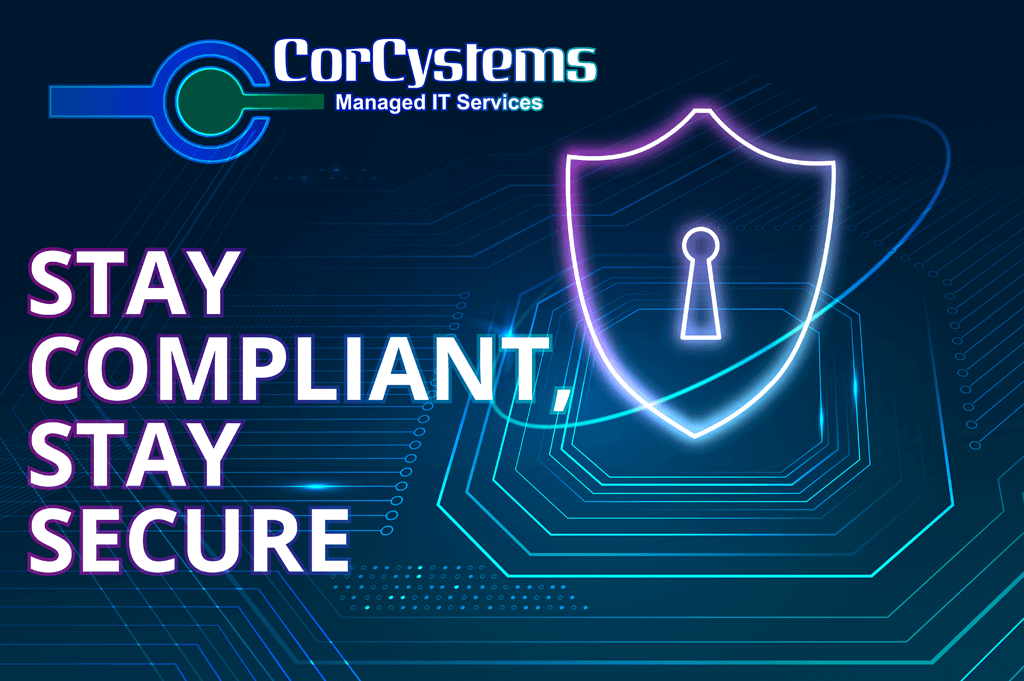
As a business owner, the safety and security of your company’s assets and customers’ information are crucial. That’s where cybersecurity comes in. Therefore, it’s critical to understand the different aspects of a good cybersecurity plan. Unfortunately, small businesses are often targeted by cybercriminals. According to a National Cyber Security Alliance report, 60% of small businesses that suffer a cyber-attack go out of business within six months. The average cost of a cyber-attack for small and medium-sized businesses can come in over $100,000.
In this article, we’ll look closely at three major cybersecurity areas: governance, risk management, and compliance. We’ll also give you tips and best practices for each area and explain how CorCystems can help you.
Governance
Cybersecurity governance refers to the overall management and oversight of an organization’s cybersecurity program. It involves setting policies, procedures, and standards for the protection of sensitive data and systems, as well as the management of risk.
Governance also includes establishing the roles and responsibilities for cybersecurity initiatives within the organization and the communication and training of employees.
Cybersecurity Policy Management
Policy management in cybersecurity involves a combination of top-down and bottom-up approaches. From the top down, it’s essential to have a clear and comprehensive cybersecurity strategy in place, outlining the organization’s overall goals and objectives. From the bottom up, it’s necessary to involve employees in developing and implementing policies and providing training and education on cybersecurity best practices.
Types of cybersecurity governance policies
There are several types of cybersecurity governance policies that organizations should consider, including:
- Access control policies, which outline the rules and procedures for granting access to sensitive data and systems
- Incident response policies, which outline the procedures for responding to and managing cybersecurity incidents
- Data security policies, which outline the procedures for protecting sensitive data and information
- Network security policies, which outline the procedures for protecting the organization’s network and systems
- Compliance policies, which outline the procedures for ensuring compliance with relevant regulations and standards, such as HIPAA Security Compliance and PCI Compliance Management
Best Practices for Cybersecurity Governance Policies
When implementing cybersecurity governance policies, there are several best practices to keep in mind. These include:
- Involving employees in the development and implementation of policies
- Conducting regular reviews and updates of policies to ensure they remain relevant and effective
- Holding employees accountable for adherence to policies
- Communicating policies clearly and consistently across the organization
- Providing training and education to employees
- Partnering with a trusted service provider who can manage more technical pieces
[Related: Importance of IT Strategy]
Risk Management
What is Cybersecurity Risk?
Cybersecurity risk refers to the potential for harm or loss to an organization’s assets and systems due to a cybersecurity incident. This can include loss of data, financial loss, damage to reputation, and more.
On a practical basis, it’s the people, devices, and connections that can expose your larger information infrastructure to the outside threats.
These external cyber threats don’t specifically need to be dark-hooded hackers trying to “break into the mainframe” in the late of the night. A careless click that exports an entire database of records can lead to instability to your larger IT ecosystem, without the proper safeguards in place.
Increasingly, as organizations move more of their operations online and rely on digital tools and applications, they are exposed to a higher cybersecurity risk. This is why it’s important for companies to be aware of potential vulnerabilities in their systems that can be exploited by attackers and take steps to address them.
[Related: 5 Industries that Need a Managed Service Provider]
How do organizations manage this cybersecurity risk?
Managing cybersecurity risk involves assessing, identifying, and mitigating potential threats and vulnerabilities within the ecosystem of your IT infrastructure. Your IT infrastructure isn’t simply your company network, but also data servers that pre-process data for business intelligence analysis, mail servers that filter and deliver your emails, and proxy servers that route network traffic between internal and external networks.
Any of these nodes are potential fail points within your IT infrastructure and require sufficient protection measures.
Typically, cyber security risk management can involve the following basic steps:
- Conducting regular security assessments
- Implementing security controls and solutions
- Developing incident response plans
At the enterprise level, this risk management is a complex and ongoing process.
Benefits of cyber security risk management
Implementing effective cybersecurity risk management can bring several benefits to an organization, including:
Reduced risk of data breaches and other cybersecurity incidents
According to a report by Cybersecurity Ventures, small and medium-sized businesses are targeted by cybercriminals in 43% of all cyber-attacks. By implementing effective risk management strategies, small and medium-sized businesses can reduce their risk of falling victim to a cyber-attack.
Minimized financial loss and damage to reputation in the event of an incident
The cost of a cyber-attack can be significant, with SMBs bearing the brunt of these costs averaging an estimated $2.6 million, according to a report by Hiscox. By implementing effective risk management strategies, small and medium-sized businesses can minimize the financial impact of a cyber-attack and prevent damage to their reputation.
Improved compliance with relevant regulations and standards
Small and medium-sized businesses are subject to the same laws and regulations as larger companies regarding cybersecurity. By implementing effective risk management strategies, small and medium-sized businesses can ensure compliance with relevant regulations such as HIPAA, PCI-DSS, and GDPR, which can help to avoid costly fines and penalties.
Increased confidence and trust from customers and stakeholders
With data breaches and cyber-attacks becoming more common, customers and stakeholders are becoming increasingly concerned about the security of their personal information. According to a 10,000-person survey by Gemalto, 70% of consumers would take their business elsewhere if a company had suffered a data breach. By implementing effective risk management strategies, small and medium-sized businesses can demonstrate their commitment to protecting customer and stakeholder information, which can help to build trust and confidence in the company.
Integrating Risk Management Strategies into Governance Policies
Integrating risk management strategies into governance policies is crucial for effective cybersecurity management. This includes incorporating:
- Risk assessment of roles, privileges, and file types
- Mitigation measures into access control policies
- Incident response policies
- Data security policies
- Network security policies
- Compliance policies
Additionally, regular reviews and updates of these policies should be conducted to ensure they take into account the latest threats and vulnerabilities.. Organizations can create a more comprehensive and effective approach to cybersecurity governance by integrating risk management strategies.
Cybersecurity Compliance
Cybersecurity compliance refers to the adherence to relevant laws, regulations, and standards related to protecting sensitive data and systems. Given the dynamic way in which cyber threats can emerge and evolve, cyber security compliance has to be a continuous process. In spite of the additional burdens required by compliance’s requirements, organizations must demonstrate this compliance through regular reporting and third-party assessments.
Basically, cyber security compliance functions as a way to establish a common set of minimum standards within an industry.
How Compliance Works in Healthcare
Within the healthcare industry, you might have heard about the HIPAA Privacy Rule. While trying to standardize how electronic health information was shared by what was increasingly becoming digital channels, HIPAA provisions simultaneously wanted to safeguard a patient’s protected health information (PHI).
To improve efficiency within industry, the creators of HIPAA needed to establish standards for the format and content of electronic health information. For patients to feel secure that their PHI was safe with their medical providers, HIPAA’s privacy provisions began requiring those healthcare providers to implements various controls on document access, procedures for encryption and decryption of patients’ PHI, ransomware back-ups, and plans for cyber incident response.
Other industries have their own compliance standards to follow, such as the General Data Protection Regulation (GDPR) for companies operating in the European Union.
Types of cybersecurity compliance frameworks
Maintaining cybersecurity compliance involves staying informed about relevant laws and regulations and implementing policies and procedures to meet compliance requirements. This can include conducting regular assessments and audits, implementing security controls, and providing employee training and education.
There are several types of cybersecurity compliance frameworks that organizations should consider, including:
- NIST Cybersecurity Framework: A framework developed by the National Institute of Standards and Technology that provides guidelines for managing cybersecurity risks, with compliance to the NIST-800 171 framework being one of the most prominent.
- ISO 27001: A standard for information security management systems (ISMS) that requires organizations to implement a comprehensive set of IT security controls and procedures to protect their sensitive information and assets.
- PCI DSS: A set of standards for protecting payment card data, ensuring strong access control measures, and regularly monitoring their networks to ensure their PCI compliance management is robust.
- SOC: A set of standards for evaluating the security and privacy controls of a service provider’s systems as well as for determining the operational effectiveness of those systems.
Cybersecurity governance, risk management, and compliance are all critical components of an effective cybersecurity strategy. By understanding the importance of each of these areas and implementing best practices and strategies for managing them, organizations can better protect their assets and data and ensure compliance with relevant regulations and standards.
CorCystems can help with all of these areas, from policy development and implementation to risk management and compliance, including HIPAA Security Compliance, PCI Compliance Management, FFIEC Risk Assessment & Management, NIST Cybersecurity Protection, and SOC and SIEM Monitoring. Contact CorCystems today to learn more about how we can help your organization improve its cybersecurity.



